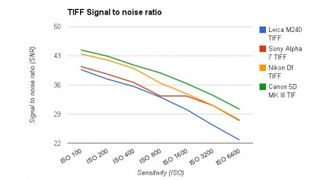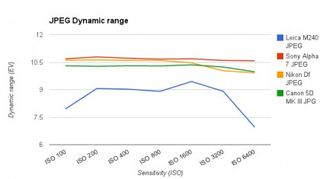Why you can trust TechRadar
We shoot a specially designed chart in carefully controlled conditions and the resulting images are analysed using DXO Analyzer software to generate the data to produce the graphs below.
A high signal to noise ratio (SNR) indicates a cleaner and better quality image.
For more more details on how to interpret our test data, check out our full explanation of our noise and dynamic range tests.
Here we compare the Leica M 240 with the Sony A7, Nikon Df and Canon 5D Mark III.
JPEG signal to noise ratio

The Leica M's JPEGS have a significantly lower signal to noise ratio than those from the Sony a7, Nikon Df and Canon EOS 5D Mark III. The results look similar at low ISOS, but at ISO 800 and beyond the Leica's images are noticeably noisier.
Raw signal to noise ratio

The Leica's raw files show a lower signal to noise ratio too. Images will look visibly noisier, especially at high ISOs. However, the level of noise reduction applied on the sensor and during image processing can vary from one maker to another – Leica may be opting for 'noisy and sharp' rather than 'smooth' images.
JPEG dynamic range

This is a very curious set of results from the Leica's JPEGs, suggesting Leica may have deliberately chosen a high-contrast 'punchy' rendering.
Raw dynamic range

The Leica's raw files tell a different story. Here, the dynamic range is up there with the best of its rivals – if you want the best tonal range from this camera, you need to shoot raw.
Current page: Noise and dynamic range
Prev Page Image quality and resolution Next Page Sensitivity and noise images